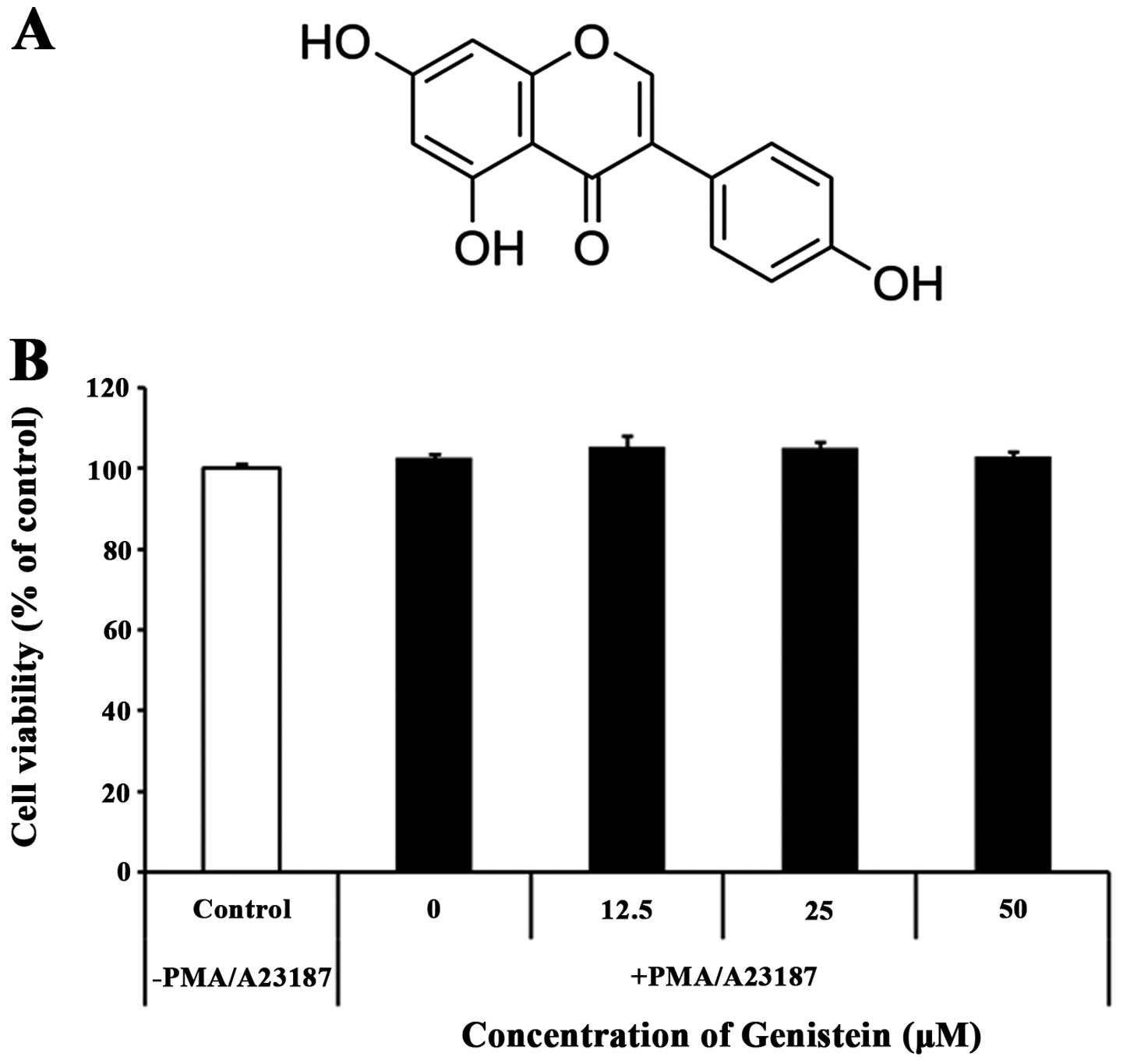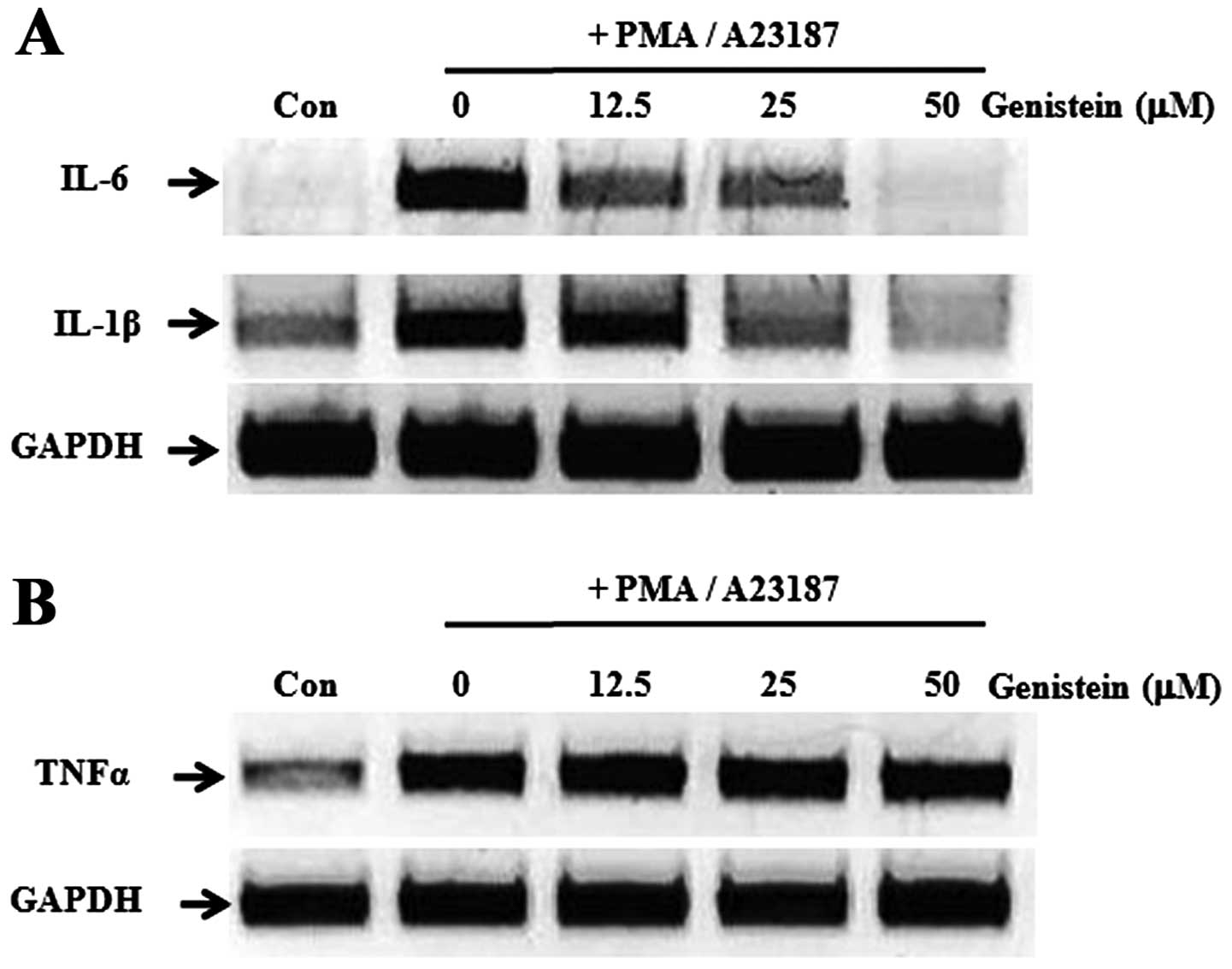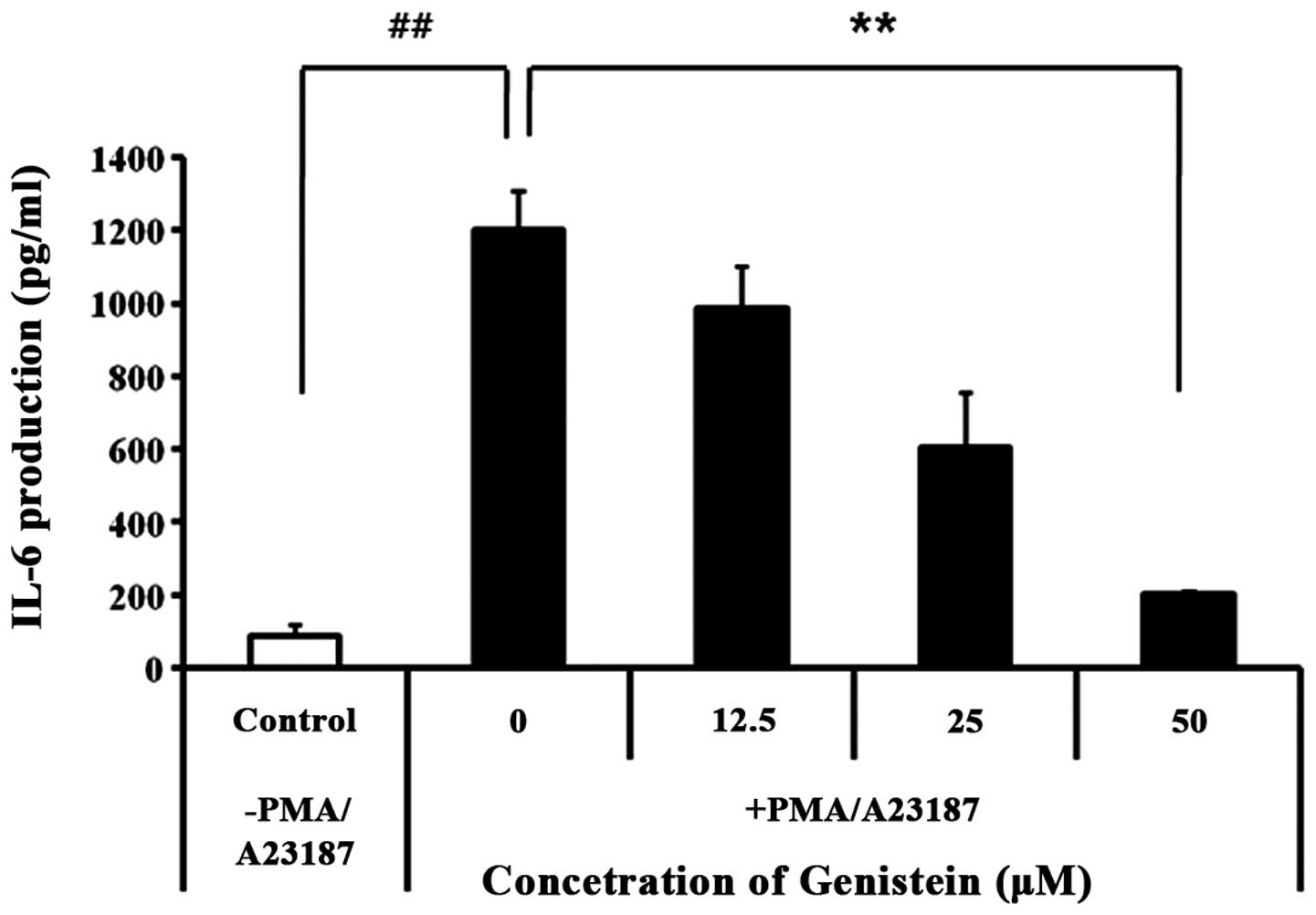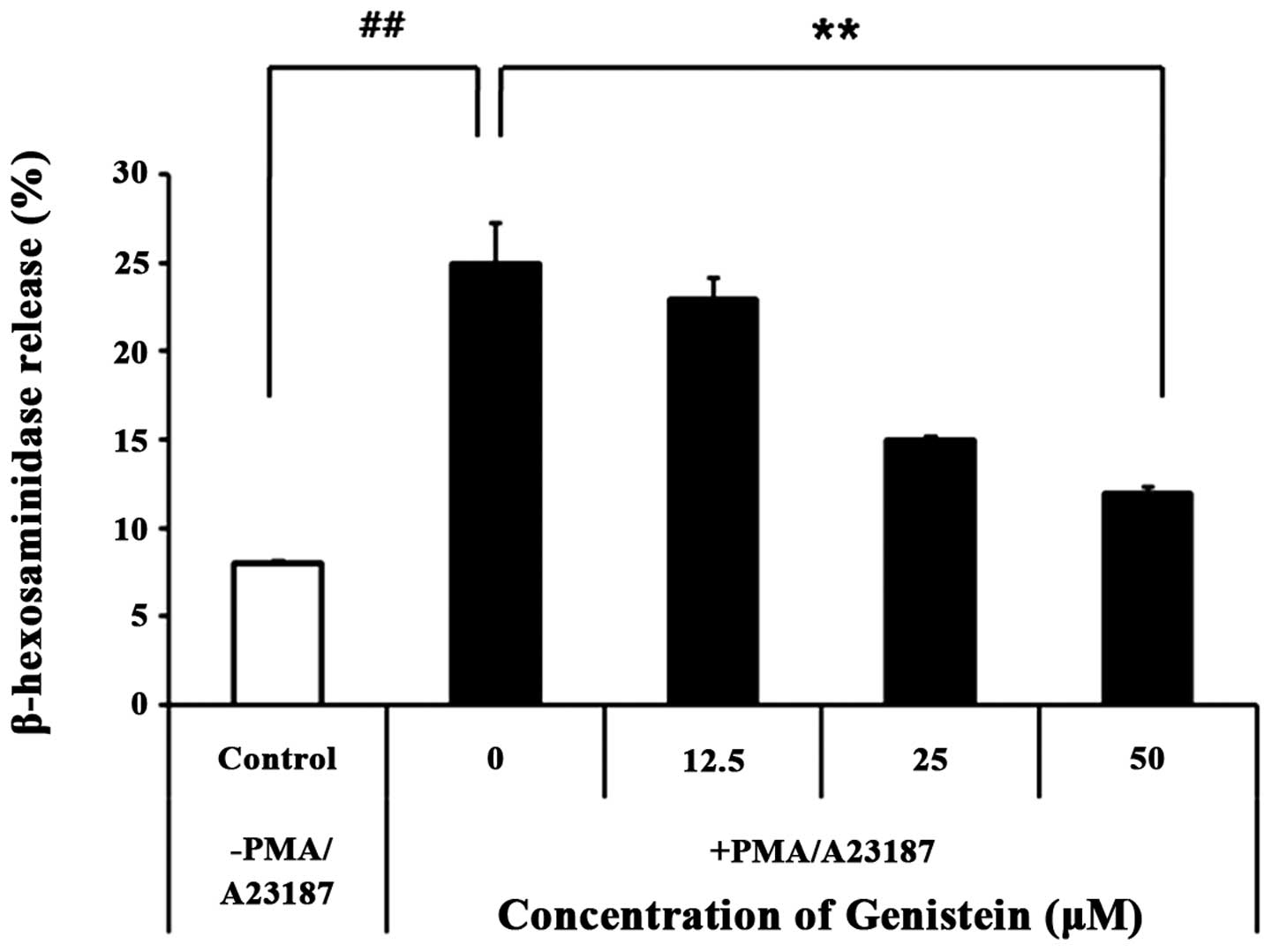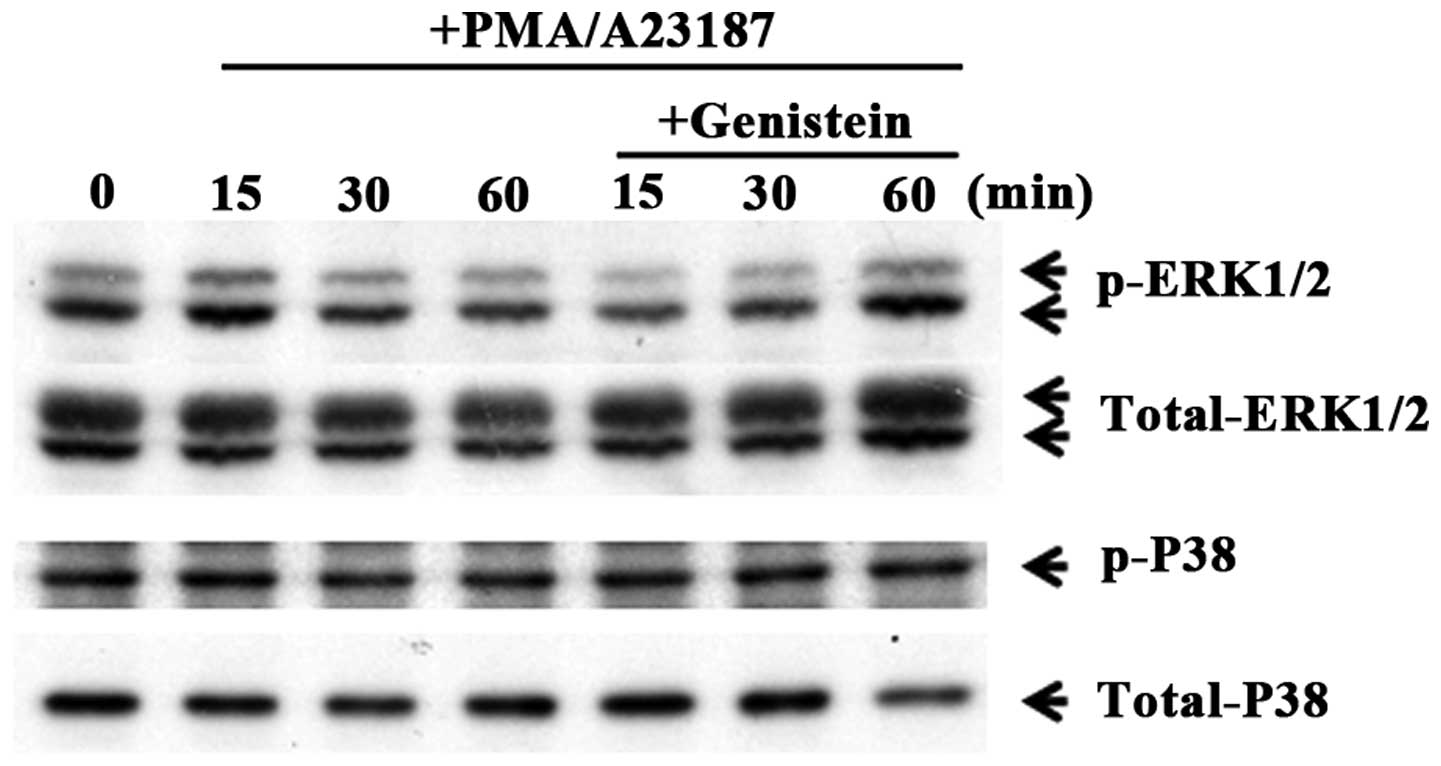Genistein inhibits pro‑inflammatory cytokines in human mast cell activation through the inhibition of the ERK pathway
- Authors:
- Published online on: October 2, 2014 https://doi.org/10.3892/ijmm.2014.1956
- Pages: 1669-1674
Abstract
Introduction
Allergic responses frequently occur in developed nations, with anaphylactic shock being particularly fatal (1). Anaphylactic shock is a rapidly occurring, severe allergic response that may cause mortality (2). Anaphylaxis can occur in response to any foreign substance, including venom from insects, foods and medications (3–5). Globally, 0.05–2% of people are estimated to suffer anaphylaxis during their lifetime and this rate appears to be increasing (6). Avoiding the specific triggers, such as foods and medications, is critically imporant to prevent anaphylaxis (7). However, this is not always possible. Thus, development of immunoadjuvants is essential for preventing anaphylaxis and allergic reactions.
Mast cells derived from hematopoietic cells are associated with tissue immunity and innate immunity and play an significant role in allergic and anaphylactic reactions (1). Mast cells can secrete pre-formed mediators, including histamine, heparin and inflammatory cytokines, by degranulation (8,9). Antigen immunoglobulin E (IgE)-dependent-activated mast cells induce degranulation to secrete three types of mediators. Several inflammatory and chemotactic cytokines, such as interleukin (IL)-1β, IL-6 and tumor necrosis factor (TNF)-α, are produced from activated mast cells (10). Additionally, these pro-inflammatory cytokines support the well-recognized role of mast cells in allergic inflammation and hypersensitivity (10). Histamine release from mast cells stimulates cardiac contraction, vascular permeability and anaphylaxis; the IgE-dependent pathway, which results in histamine release, is part of the mechanism associated with anaphylaxis (1).
The production of these cytokines is transmitted through signal molecules, such as the transcription factors mitogen-activated protein kinase (MAPK) and nuclear factor (NF)-κB (11,12). MAPKs are expressed and activated in a systemic inflammatory disorder and play an important role in the control of cytokines, chemokines and cell proliferation (13). As transcriptional factors, MAPK and NF-κB play a pivotal role in inflammation by virtue of their ability to induce transcription of an array of inflammatory genes, particularly the regulation of pro-inflammatory molecules, including IL-1β, IL-6 and TNF-α (14,15).
The phytoestrogen genistein (4′,5,7-trihydroxyisoflavone) is an isoflavonoid compound containing soy beans. Genistein has a variety of biological effects, including anti-inflammatory and antioxidant properties, and inhibits protein tyrosine kinases (PTK) and influences immune responses (16,17). Genistein also modulates the activation of NF-κB and Akt during inflammation (18). Immortalized human mammary epithelial cells demonstrated decreased extracellular signal-regulated kinase (ERK)1/ERK2 phosphorylation when treated with genistein, specifically inhibiting cytokine-induced ERK phosphorylation (19). Several animal studies indicate that genistein reduces production of pro-inflammatory molecules, such as IL-6 and TNF-α, in rat plasma. In addition, in an acute liver inflammation model, oral administration of soy-derived genistein suppresses IL-6, IL-1β and TNF-α in RAW264.7 macrophages (20,21). However, the signaling pathways involved in the anti-inflammatory effect of genistein on human mast cell activation remain unknown.
The aim of the present study was to investigate the anti-inflammatory effects of genistein on phorbol 12-myristate 13-acetate (PMA)- and A23187-, a calcium ionophore, induced expression of pro-inflammatory cytokines and histamine release, as well as their associated regulatory signaling pathways.
Materials and methods
Cell culture and genistein treatment
The human leukemic mast cell (HMC)-1 line was obtained from Dr Dae Ki Kim at Chunbuk National University (Jeonju-si, Korea). HMC-1 were cultured in Iscove’s modified Dulbecco’s medium (IMDM) supplemented with 10% heat-inactivated fetal bovine serum, 100 IU/ml penicillin, and 100 μg/ml streptomycin (PAA Laboratories Inc., Piscataway, NJ, USA) at 37°C and 5% CO2. Genistein was dissolved in dimethyl sulfoxide (DMSO) (Sigma, St. Louis, MO, USA) and diluted to the desired concentration in IMDM (final DMSO concentration 0.1% v/v). An equal amount of DMSO was added to the control samples (medium only).
Cell viability
Cell viability was measured by the 3-[4,5-dimethylthiazol-2-yl]-2,5 diphenyl tetrazolium bromide (MTT) assay. HMC-1 (2×104 cells/well) were seeded in 96-well U-bottom culture plates with IMDM and incubated at 37°C and 5% CO2. Cells were treated with various concentrations of genistein (12.5–50 μmol/ml) and incubated at 37°C for 24 h. Following treatment, MTT (0.5 mg/ml) in medium was added to each well and cells were incubated at 37°C for 4 h. Following incubation, the MTT solution was removed and the formazan product was dissolved in a solvent (DMSO:ethanol = 1:1) generating a colored solution. Absorbance was measured by an enzyme-linked immunosorbent assay (ELISA) microplate reader at a wavelength of 570 nm (BioTek, Winooski, VT, USA).
RNA isolation and reverse transcription PCR (RT-PCR)
Total RNA was isolated from genistein-treated cells using TRI reagent (Sigma) according to the manufacturer’s instructions. To synthesize cDNA, 0.5 μg of total RNA was primed with oligo(dT) and reacted with a mixture of Moloney murine leukemia virus reverse transcriptase (M-MLV reverse transcriptase), dNTP and reaction buffer (Promega, Madison, WI, USA). The mRNA levels of inflammatory cytokines were measured using synthetic cDNA and selective primers for PCR: IL-6 forward, GAG GCA CTG GCA GAA AAC AA; and reverse, TTG GGT CAG GGG TGG TTA TT; IL-1β forward, GTA CCT GAG CTC GCC AGT GA; and reverse, TGA AGC CCT TGC TGT AGT GG; TNF-α forward, CCA TCA GAG GGC CTG TAC CT; and reverse, CAG ACT CGG CAA AGT CGA GA; GAPDH forward, AAG GGT CAT CAT CTC TGC CC; and reverse, GTG ATG GCA TGG ACT GTG GT. The PCR products were stained with Loading Star (Dynebio co., Ltd., Seongnam-si, Korea) and electrophoresed on a 1% agarose gel. The bands were detected by a UV transilluminator (Core Bio, La Jolla, CA, USA).
Western blot analysis
HMC-1 (2×106 cells/well) were seeded in a 60Φ cell culture dish and starved with serum-free IMDM for 6 h. After starvation, cells were pretreated with genistein for 30 min, and stimulated with 20 nmol/l PMA and 1 μmol/l of the calcium ionophore, A23187, for 15, 30 and 60 min. Treated cells were washed with cold phosphate-buffered saline and lysed with modified radioimmunoprecipitation assay buffer [50 mmol/l Tris-HCl, 0.1% sodium dodecyl sulfate (SDS), 0.5% sodium deoxycholate, 1% NP-40 and 150 mmol/l sodium chloride (pH 8.0)] at 4°C for 30 min. The lysates were centrifuged at 13,000 × g for 15 min and the supernatant was used as protein samples. Protein concentration was measured according to the manufacturer’s instructions by colorimetric bicinchoninic acid kit (Thermo Scientific, Pittsburgh, PA, USA). Equivalent amounts of protein were separated by 10% SDS-polyacrylamide gel electrophoresis and electrophoretically transferred to polyvinylidene fluoride membrane (Millipore, Billerica, MA, USA). The membranes were incubated with blocking solution (5% skimmed milk in Tris-buffered saline TBS) for 1 h. Following blocking, membranes were probed with anti-ERK (sc-292838), anti-p-ERK (sc-7383), anti-p38 (sc-535) and anti-p-p38 (sc-7973) primary antibodies (Santa Cruz Biotechnology, Inc., Santa Cruz, CA, USA), and with horseradish peroxidase (HRP)-conjugated anti-rabbit or anti-mouse secondary antibodies (Santa Cruz Biotechnology) for 2 h. Bands were visualized using an enhanced chemiluminescence (Bio-Rad Laboratories, Hercules, CA, USA) detection system and exposed to radiographic film.
ELISA
HMC-1 (2×104 cells/well) were seeded in 96-well U-bottom culture plates. Cells were pretreated with various concentrations of genistein (12.5–50 μmol/l) for 30 min, and stimulated with PMA/A23187 for 48 h. Cultured cells were separated by microcentrifugation and the supernatant was used for samples. IL-6 release was measured by Human IL-6 ELISA MAX™ Deluxe Sets (BioLegend, San Diego, CA, USA), according to the manufacturer’s instructions. Briefly, standards and samples were incubated on a capture antibody-coated plate overnight at 4°C. The detection antibody was added and samples were incubated for 1 h and avidin-HRP bound to the detection antibody. Substrate solution was added to each well, and the reaction was stopped by addition of a stop solution (2N H2SO4). Absorbance was measured by an ELISA microplate reader at a wavelength of 405 nm.
β-hexogeminidase assay
HMC-1 (5×105 cells/well) were seeded in 24-well plates with IMDM. After a 10-min incubation at 37°C, cells were pretreated with genistein for 30 min followed by stimulation with PMA/A23187 for 1 h. Cultured cells were collected by centrifugation (1,500 × g) for 5 min. The pellet and supernatant were transferred to separate microtubes. The pellet was lysed with 1% Triton X-100 in Tris-HCl (pH 8.0) for 20 min at 4°C. The lysate (50 μl) was combined with 50 μl 2 mM p-nitrophenyl-N-acetyl-β-D-glucosaminide (Calbiochem, Canada) dissolved in 0.1 mol/l citrate buffer (pH 4.5) for 1 h at 37°C. The reaction was ended with 100 μl of a stop solution (0.1 mol/l NaHCO3/Na2CO3), and the absorbance was measured at 405 nm using an ELISA microplate reader.
Statistical analysis
All the results are expressed as the mean ± standard deviation of the indicated number of the experiments. Statistical significance was estimated using a Student’s t-test for unpaired observations, and the differences were compared with regard to statistical significance by one-way analysis of variance, followed by Bonferroni’s post-hoc test. The categorical data from the fertility test were subjected to statistical analysis via the χ2 test.
Results
Genistein had no effect on cytotoxicity in a human mast cell line (HMC-1)
In an initial series of experiments, whether genistein influenced the cytotoxicity of a human mast cell line (HMC-1) was investigated. HMC-1 cells were treated with various concentrations of genistein, ranging from 0 to 50 μM, for 24 h and subjected to an MTT assay. As shown in Fig. 1B, the addition of 50 μM genistein did not alter HMC-1 numbers when compared to the control or cells treated with only medium [DMSO (0.02%) in IMDM]. Therefore, this range of genistein concentrations was used to determine the anti-inflammatory effects of genistein during mast cell activation.
Genistein suppresses the expression levels of pro-inflammatory cytokines in PMA/A23187-induced HMC-1
Pro-inflammatory cytokines are important mediators of inflammation, cell recruitment and allergenic responses (22). To evaluate the effect of genistein on the gene expression of pro-inflammatory cytokines, HMC-1 was initially treated with genistein and the cells were stimulated with PMA (20 nM) and A23187 (1 μM), prior to analyzing the gene expression of the pro-inflammatory cytokines using RT-PCR. As shown in Fig. 2A, a high level of genistein (50 μM) significantly suppressed the gene expression of IL-1β and IL-6. However, TNF-α gene expression remained unaltered (Fig. 2B).
Genistein significantly inhibits IL-6 production in PMA/A23187-induced HMC-1
IL-6 is crucial for mast cell maturation; activated mast cells increase IL-6 mRNA associated with protein kinase C (PKC) activity and also upregulate histamine production (23). We found that genistein suppressed gene expression of pro-inflammatory cytokines IL-1β and IL-6 (Fig. 2A). To confirm the effect of genistein on the gene expression of pro-inflammatory cytokines, culture supernatants were assayed for cytokine levels by ELISA. HMC-1 cells were pretreated with genistein (12.5–50 μM) for 30 min, and subsequently stimulated with PMA and A23187 for 48 h. As shown in Fig. 3, genistein strongly decreased the production of IL-6 in PMA/A23187-induced HMC-1. These results indicate that genistein inhibits pro-inflammatory cytokines, such as IL-1β and IL-6 in PMA/A23187-activated HMC-1.
Genistein inhibits histamine release in PMA/A23187-induced HMC-1
In order to determine the effect of genistein on mast cells degranulation, the effect of genistein was investigated on the release of β-hexosaminidase, a secretory granule marker that is released in parallel with histamine. As shown in Fig. 4, 50 μM genistein reduced β-hexosaminidase release by 2-fold, indicating that genistein inhibits mast cell degranulation.
Genistein regulates phosphorylation of ERK
To evaluate the mechanism of the effect of genistein on gene expression of pro-inflammatory cytokines, the influence of genistein on MAPK phosphorylation was investigated. IL-1β and IL-6 expression is regulated by a transcription factor, NF-κB, and activated by MAPK pathways (24). In order to investigate the effects of genistein on the MAPK signaling pathways, HMC-1 cells were pretreated with 50 μM genistein and kinase activation was assessed. Phosphorylation of p38 MAPK and ERK1/2 were measured by phosphor-specific western blotting. As shown in Fig. 5, genistein inhibited the phosphorylation of ERK1/2 in PMA/A23187-induced mast cells. These results indicate that genistein inhibits pro-inflammatory cytokine production via regulation of the ERK pathways.
Discussion
Allergic diseases, including asthma and anaphylaxis, are a severe health burden for a number of nations. In the United States, an estimated 20 million patients are treated for allergic diseases, at an annual cost exceeding $15 billion (25). Anaphylaxis is a type I hypersensitivity reaction mediated by IgE-activated mast cells and occurs locally and systemically; it is caused by various inflammatory mediators, such as histamine, tryptase and several cytokines from activated mast cells. These inflammatory mediators affect leukocyte recruitment, and cause vasodilation, increased vascular permeability and bronchial-constriction (26). Therefore, numerous investigators have sought to develop novel therapeutic adjuvants for allergenic inflammation via regulation of mast cells. To address this, the anti-inflammatory effects of genistein, a phytoestrogen, were investigated on mast cell activation.
In general, PMA activates PKC, resulting in activation of mast cells. In addition, the calcium ionophore, A23187, increases the permeability of the cell membrane to Ca2+ and can selectively activate gene expression of calcium-regulated genes (27). In addition, A23187 alone has been shown to induce granule release in mast cells (8). The present study assessed HMC-1, an immature human mast cell line derived from the peripheral blood of a patient suffering from mast cell leukemia. HMC-1 lacks FcɛRI, making it difficult to activate the mast cells through IgE-mediated responses. In addition, co-treatment with PMA and A23187 was also used to activate mast cells.
Genistein is a phytoestrogen isolated from Genista tinctoria; the chemical name is derived from the generic name. Kim et al (28) reported that genistein-4′-O-α-L-rhamnopyranosyl-(1→2)- β-D-glucopyranoside from Sophora japonica (Leguminosae) ameliorates mast cell-mediated allergic inflammation in vivo and in vitro. In addition, the study by Kim et al indicates that the anti-inflammatory effect of the genistein compound is involved in the regulation of inflammatory cytokines, including IL-8 and TNFα. A recent study found that genistein inhibited transcription factors, including GATA-binding protein-3 and signal transducer and activator of transcription-6, which control the Th1/Th2 response in an asthma mouse model. Specifically, genistein decreased Th2-type cytokine levels and attenuated ovalbumin-induced airway inflammation (29). However, the underlying mechanisms by which genistein inhibits inflammatory mediators in mast cell activation remain unknown.
To the best of our knowledge, this is the first study showing that genistein inhibits pro-inflammatory cytokines in activated mast cells. Genistein was found to significantly suppress IL-1β and IL-6 expression in PMA/A23187-induced mast cells (Fig. 2A). In general, mast cells release an array of mediators with the potential to cause allergic inflammation, such as the pro-inflammatory cytokines, IL-1β, IL-6 and TNF-α. Specifically, IL-1β plays an important role in allergic response; the local accumulation of IL-6 is associated with a local allergic reaction, and IL-1β and IL-6 promote inflammation and a mast cell-mediated immune response (30–32). These studies indicate that reduction of pro-inflammatory cytokines from mast cells is one of the keys to reducing inflammatory symptoms. The results of the present study, showing inhibition of IL-1β and IL-6 expression by genistein, support the idea that genistein has an anti-inflammatory effect resulting from the reduction of these mediators in mast cells. Additionally, the induction of these cytokines was involved in the activation of the MAPK and NF-κB pathway. The study by Blackwell et al (33) reported on the role of NF-κB activation in the regulation of cytokine production in allergic inflammation, and showed that NF-κB activation is also associated with MAPK activation. To address this, the inhibitory effect of genistein was investigated on pro-inflammatory cytokines via regulation of MAPK activation. Genistein inhibited the phosphorylation of ERK. However, p38 MAPK levels were not altered by pretreatment with genistein in activated mast cells (Fig. 5). These results indicate that the inhibitory effect of genistein on pro-inflammatory cytokine production is associated with ERK signaling pathways.
In conclusion, genistein inhibits the gene expression and production of pro-inflammatory cytokines IL-1β and IL-6, but does not alter TNF-α levels. Additionally, genistein attenuates activation of the ERK signaling pathway. The present study also indicates that genistein has potential for use as a treatment for allergic inflammation and anaphylactic shock.
Acknowledgements
The present study was financially supported by the Ministry of Education, Science Technology (MEST) and National Research Foundation of Korea (NRF) through the Human Resource Training Project for Regional Innovation (2011-04-Dae-05-016) and the Leading Foreign Research Institute Recruitment Program through the National Research Foundation of Korea (NRF) funded by the Ministry of Education, Science and Technology (MEST) (2011-0030034).
References
|
Metcalfe DD, Peavy RD and Gilfillan AM: Mechanisms of mast cell signaling in anaphylaxis. J Allergy Clin Immunol. 124:639–646. 2009. View Article : Google Scholar : PubMed/NCBI | |
|
Oskeritzian CA, Price MM, Hait NC, et al: Essential roles of sphingosine-1-phosphate receptor 2 in human mast cell activation, anaphylaxis, and pulmonary edema. J Exp Med. 207:465–474. 2010. View Article : Google Scholar : PubMed/NCBI | |
|
Worm M: Epidemiology of anaphylaxis. Chem Immunol Allergy. 95:12–21. 2010. View Article : Google Scholar | |
|
Boden SR and Wesley Burks A: Anaphylaxis: a history with emphasis on food allergy. Immunol Rev. 242:247–257. 2011. View Article : Google Scholar : PubMed/NCBI | |
|
Lee JK and Vadas P: Anaphylaxis: mechanisms and management. Clin Exp Allergy. 41:923–938. 2011. View Article : Google Scholar : PubMed/NCBI | |
|
Simons FE: World Allergy Organization survey on global availability of essentials for the assessment and management of anaphylaxis by allergy-immunology specialists in health care settings. Ann Allergy Asthma Immunol. 104:405–412. 2010. View Article : Google Scholar : PubMed/NCBI | |
|
Simons FE: Anaphylaxis: recent advances in assessment and treatment. J Allergy Clin Immunol. 124:625–636. 2009. View Article : Google Scholar : PubMed/NCBI | |
|
Zhang B, Alysandratos KD, Angelidou A, et al: Human mast cell degranulation and preformed TNF secretion require mitochondrial translocation to exocytosis sites: relevance to atopic dermatitis. J Allergy Clin Immunol. 127:1522–1531. 2011. View Article : Google Scholar | |
|
Tchougounova E, Pejler G and Abrink M: The chymase, mouse mast cell protease 4, constitutes the major chymotrypsin-like activity in peritoneum and ear tissue. A role for mouse mast cell protease 4 in thrombin regulation and fibronectin turnover. J Exp Med. 198:423–431. 2003. View Article : Google Scholar : PubMed/NCBI | |
|
Lee S, Park HH, Son HY, et al: DA-9601 inhibits activation of the human mast cell line HMC-1 through inhibition of NF-κB. Cell Biol Toxicol. 23:105–112. 2007.PubMed/NCBI | |
|
Shin J, Pan H and Zhong XP: Regulation of mast cell survival and function by tuberous sclerosis complex 1. Blood. 119:3306–3314. 2012. View Article : Google Scholar : PubMed/NCBI | |
|
Kalesnikoff J and Galli SJ: New developments in mast cell biology. Nat Immunol. 9:1215–1223. 2008. View Article : Google Scholar : PubMed/NCBI | |
|
Guma M, Kashiwakura J, Crain B, et al: JNK1 controls mast cell degranulation and IL-1β production in inflammatory arthritis. Proc Natl Acad Sci USA. 107:22122–22127. 2010.PubMed/NCBI | |
|
Lu Y, Piao D, Zhang H, et al: Saucerneol F inhibits tumor necrosis factor-α and IL-6 production by suppressing Fyn-mediated pathways in FcɛRI-mediated mast cells. Food Chem Toxicol. 59:696–702. 2013.PubMed/NCBI | |
|
Lee J and Lim KT: Expression of TNF-α and IL-6 in HMC-1 cells treated with bisphenol A is attenuated by plant-originating glycoprotein (75 kDa) by blocking p38 MAPK. Naunyn Schmiedebergs Arch Pharmacol. 382:51–61. 2010. | |
|
Masilamani M, Wei J, Bhatt S, Paul M, Yakir S and Sampson HA: Soybean isoflavones regulate dendritic cell function and suppress allergic sensitization to peanut. J Allergy Clin Immunol. 128:1242–1250. 2011. View Article : Google Scholar : PubMed/NCBI | |
|
Dixon RA and Ferreira D: Genistein. Phytochemistry. 60:205–211. 2002. View Article : Google Scholar | |
|
Kitaura J, Asai K, Maeda-Yamamoto M, Kawakami Y, Kikkawa U and Kawakami T: Akt-dependent cytokine production in mast cells. J Exp Med. 192:729–740. 2000. View Article : Google Scholar : PubMed/NCBI | |
|
Frey RS and Singletary KW: Genistein activates p38 mitogen-activated protein kinase, inactivates ERK1/ERK2 and decreases Cdc25C expression in immortalized human mammary epithelial cells. J Nutr. 133:226–231. 2003. | |
|
Zhao JH, Arao Y, Sun SJ, Kikuchi A and Kayama F: Oral administration of soy-derived genistin suppresses lipopolysaccharide-induced acute liver inflammation but does not induce thymic atrophy in the rat. Life Sci. 78:812–819. 2006. View Article : Google Scholar | |
|
Palanisamy N, Kannappan S and Anuradha CV: Genistein modulates NF-κB-associated renal inflammation, fibrosis and podocyte abnormalities in fructose-fed rats. Eur J Pharmacol. 667:355–364. 2011. | |
|
Woolley DE and Tetlow LC: Mast cell activation and its relation to proinflammatory cytokine production in the rheumatoid lesion. Arthritis Res. 2:65–74. 2000. View Article : Google Scholar : PubMed/NCBI | |
|
Conti P, Kempuraj D, Di Gioacchino M, et al: Interleukin-6 and mast cells. Allergy Asthma Proc. 23:331–335. 2002. | |
|
de Bittencourt Pasquali MA, Gelain DP, Zeidan-Chulia F, et al: Vitamin A (retinol) downregulates the receptor for advanced glycation endproducts (RAGE) by oxidant-dependent activation of p38 MAPK and NF-κB in human lung cancer A549 cells. Cell Signal. 25:939–954. 2013.PubMed/NCBI | |
|
Pullen NA, Barnstein BO, Falanga YT, et al: Novel mechanism for FcɛRI-mediated signal transducer and activator of transcription 5 (STAT5) tyrosine phosphorylation and the selective influence of STAT5B over mast cell cytokine production. J Biol Chem. 287:2045–2054. 2012. | |
|
Galli SJ, Tsai M and Piliponsky AM: The development of allergic inflammation. Nature. 454:445–454. 2008. View Article : Google Scholar : PubMed/NCBI | |
|
Resendez E Jr, Ting J, Kim KS, Wooden SK and Lee AS: Calcium ionophore A23187 as a regulator of gene expression in mammalian cells. J Cell Biol. 103:2145–2152. 1986. View Article : Google Scholar : PubMed/NCBI | |
|
Kim SJ, Kim YJ, Lee JH, et al: Genistein-4′-O-α-L-rhamnopyranosyl-(1→2)-β-D-glucopyranoside from Sophora japonica (Leguminosae) ameliorates mast cell-mediated allergic inflammation in vivo and in vitro. Orient Pharm Exp Med. 11:207–213. 2011. | |
|
Gao F, Wei D, Bian T, et al: Genistein attenuated allergic airway inflammation by modulating the transcription factors T-bet, GATA-3 and STAT-6 in a murine model of asthma. Pharmacology. 89:229–236. 2012. View Article : Google Scholar : PubMed/NCBI | |
|
Yu SC and Li XY: Effect of ginsenoside on IL-1β and IL-6 mRNA expression in hippocampal neurons in chronic inflammation model of aged rats. Acta Pharmacol Sin. 21:915–918. 2000. | |
|
Ganeshan K, Johnston LK and Bryce PJ: TGF-β1 limits the onset of innate lung inflammation by promoting mast cell-derived IL-6. J Immunol. 190:5731–5738. 2013. | |
|
Ganeshan K and Bryce PJ: Regulatory T cells enhance mast cell production of IL-6 via surface-bound TGF-β. J Immunol. 188:594–603. 2012.PubMed/NCBI | |
|
Blackwell TS, Blackwell TR and Christman JW: Impaired activation of nuclear factor-kappaB in endotoxin-tolerant rats is associated with down-regulation of chemokine gene expression and inhibition of neutrophilic lung inflammation. J Immunol. 158:5934–5940. 1997.PubMed/NCBI |



